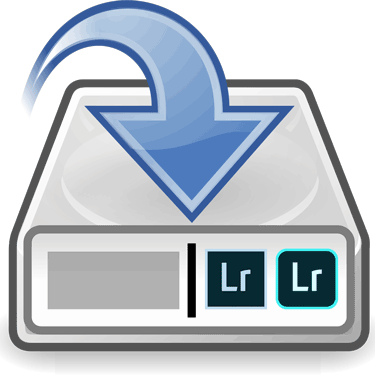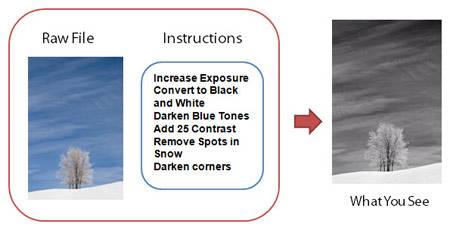 For those new to the cloud-based Lightroom CC or to Lightroom Classic, naturally you want to understand how to save your editing and other work. You’ll notice that the File menu in the menu bar suspiciously does not have “File Save” and “File Save As …” options. The short answer is that all the work you do in Lightroom – adding keywords, stars, flags and other metadata; editing your photos; creating collections or albums and more, is automatically saved as you do it – so there is no need to do a “Save” before you wrap up your session – just close the program!
For those new to the cloud-based Lightroom CC or to Lightroom Classic, naturally you want to understand how to save your editing and other work. You’ll notice that the File menu in the menu bar suspiciously does not have “File Save” and “File Save As …” options. The short answer is that all the work you do in Lightroom – adding keywords, stars, flags and other metadata; editing your photos; creating collections or albums and more, is automatically saved as you do it – so there is no need to do a “Save” before you wrap up your session – just close the program!

Lightroom CC

Lightroom Classic
It’s really important to understand that in this article, Lightroom CC refers exclusively to the new cloud-based application. Lightroom Classic refers to the current Lightroom Classic CC application, as well as to older versions – Lightroom 1-6 and Lightroom CC 2015. (Yes, this is confusing, thanks to Adobe’s choice of names.)
More on Saving and The Lightroom Catalog
It’s worth understanding this in more detail. First, both the cloud-based Lightroom CC and Lightroom Classic work non-destructively – meaning that they never touch your master photo files. Instead, your work is saved automatically behind the scenes as a set of instructions. In Lightroom CC and Lightroom Classic you are essentially seeing the instructions hovering over your master photos, but the instructions are not baked in to your masters. This is great, as it means that you can undo all or part of your work at any time – you can’t ruin your photo as you work on it!

This work, or instructions, are automatically saved into Lightroom’s catalog. The catalog is simply a file on your computer where your work on each of your photos in Lightroom is stored, along with other information about your photos. The catalog doesn’t contain the photos themselves, just information about them.(In Lightroom CC, the catalog is stored inside the .lrlibrary file.) (Read more about the Lightroom Classic catalog and how it relates to your photos in this article.)
Is Export in Lightroom Classic or Save To in Lightroom CC Another Way to Save My Work?
When you want to share your edited photos with the outside world, of course you can’t send people the originals plus a set of Lightroom instructions. This is when you need to create copies of your photos, with the work “baked in”. In Lightroom Classic we do this through the Export dialog – usually we create JPEG copies to share online, through email, to send out to print, etc.. In Lightroom CC, we do this by clicking on the Share icon and choosing Save To. (Don’t let the “Save To” terminology confuse you though – the choice of name for this feature is unfortunate!)
Note that many users believe they need to export (or Share>Save To) all their worked files in order to save their work – this is not the case, and will simply clutter up your hard drive with unnecessary copies. Furthermore, on these copies you can’t undo your work – it has been baked in. For most people I recommend that you export (or Share>Save To) only when you want to share photos, and once you do, delete the exported copies, since you can always create new ones to share.
The Importance of Catalog Backups
You can imagine, since the Lightroom catalog contains all the work you have ever done on any of your photos, that it is important to back it up, to protect you against two potential crises: (1) the catalog file could become corrupt and be impossible to open, and (2) your hard drive could crash or be stolen or damaged.
Cloud-based Lightroom CC users, these are taken care of for you – assuming you have internet coverage, your catalog is automatically backed up to the cloud, and Lightroom CC should automatically recover from a local hard drive crash or a corrupted catalog issue. That said, having a local backup of your hard drive(s) will enable Lightroom CC to recover more quickly – use backup software outside of Lightroom (Mac Time Machine, Windows Backup, other third party software) to back up the hard drive(s) your catalog and photos are stored on.
Lightroom Classic users: you, on the other hand, need to take care of this yourself! To protect against the first, back up your catalog using the prompt when Lightroom closes – this creates a series of backups over time that you can revert to, should your main catalog become corrupt. To protect against the second, use backup software outside of Lightroom (Mac Time Machine, Windows Backup, other third party software) to back up the hard drive(s) your catalog and photos are stored on. Read more about backing up your Lightroom Classic catalog and photos in this article. To see where your catalog is stored, in the menu bar in the top left, go to Lightroom (Mac) or Edit (PC) , Catalog Settings. It is listed on the General tab:

What I have explained so far is all that I believe beginners absolutely must know. For Lightroom Classic users who want an additional layer of protection and don’t mind delving into the topic more, there is also the option to “save to XMP“, which also puts the instruction data in the folders along with your master photos. I hope to cover this topic in another post soon, but for now understand that this is not a substitute for saving into the catalog. Be sure to sign up for my newsletter below to hear about new articles and tutorials!
[sc:signup]

Thanks again for valuable info.
Re Export to : If adjusted photos are not exported, will Lightroom have access to original photos in the event of a total hard drive failure?
Won’t we just have a set of instructions without files to work on?
I realise that unless adjusted photos are backed up, they too will also be lost.
Richard
You’re welcome, Richard. Lightroom CC uploads both the catalog and all your photos to the cloud (assuming you are connected to the internet). Once this is complete, if you then have a hard drive failure it will download all that it needs (the catalog, previews, and some or all of your photos depending on your Local Storage preferences.
If on the other hand you are using Lightroom Classic, Richard, you need to back up your hard drive so that your photos and the catalog can be recovered in case of hard drive failure.
thanks for info, keep up the good work
You’re welcome, Bob!
The difference between LR CC and LR Classic CC was well explained. You back up the Classic catalogue locally and LR CC is backed up automatically to the cloud. What about mobile applications. If I’m using LR CC on an iPad only is there a catalogue stored on the device itself and backed up to the cloud, or is it only in the cloud?
Hi Zenon, LR CC is LR CC regardless of client – meaning that it’s the same catalog, whether you’re working with LR CC Desktop, Mobile or Web. I can’t say though whether the entire catalog is stored on the iPad, or just portions of it. If you want to work on your iPad without internet access, be sure to select images or albums to store locally (that you want to work on) before you lose that internet access.
Thank You
Hi Laura,
Thank you for explaining the storage mechanism of LR CC. Is there really no way to backup the changes? Because the Originals can be stored locally and backuped locally. But without the changes it is nearly worthless. Currently I am working with LR CC Classic and sync all pictures to the LR CC (mobile) on my iPad. I am having the normal PS and LR CC plan and the LR CC 1TB plan in addition. More and more I am enjoying doing all on my iPad and consider to migrate. Without a xmp backup I feel not 100% sure when I leave all in the hand of Adobe.
Best regards
Peter
While you can choose to save a copy of your images locally in LR CC preferences, this unfortunately doesn’t place XMP files there. You’d need to manually export copies of your files choosing “Original + Settings” as the file type. Alternatively you could keep LR Classic, keep sync turned on so that all your LR CC images sync to Classic and get stored on your hard drive, and in Classic choose to save to XMP (Cmd/Ctl-S). (If you do this, don’t also store a copy of the images locally in LR CC.)
I do a lot of work on a photo but it never seems to appear when I export to file. I redo everything in Photoshop.. Figure I must be doing something wrong….I have v5.2 and apparently was too late to update to 5.7. Any idea if that’s the problem or is it just “pilot error”??
It sounds like you’re choosing “Original” as your export file type, Tom. Depending on your purpose, choose JPEG or DNG (for rare cases when you need a raw copy).
Lightroom (now called Lightroom Classic is currently on version 11, so 5 is quite old.
Thanks for answering Laura. No, I export using jpeg…yes, it sure is old….